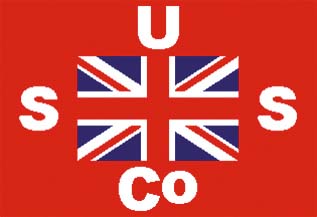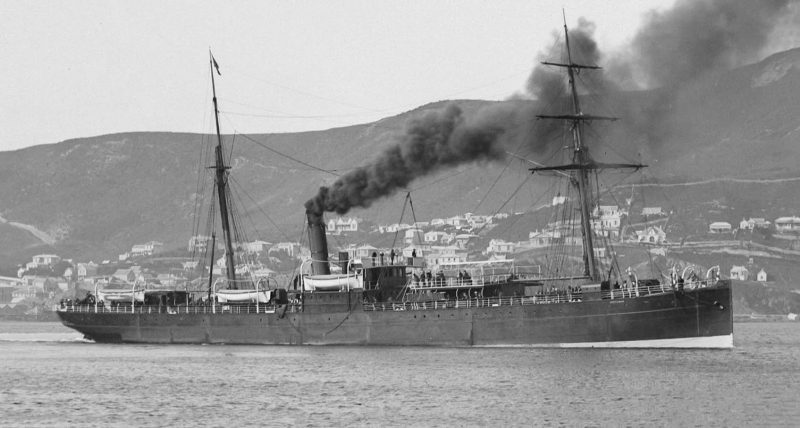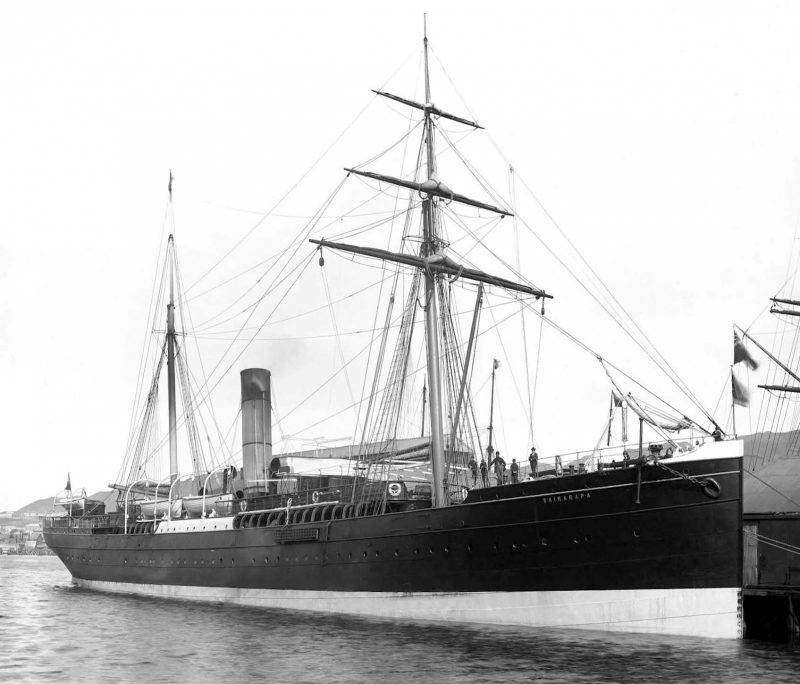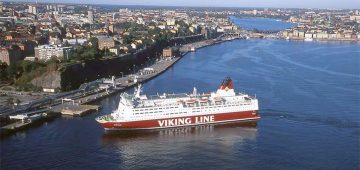125 Years of Serving New Zealand and the Antipodes – Part Two

 This second article on the services of USSNZ describes the South Pacific Islands services from both Auckland and Sydney, as well as a Pacific service to San Francisco calling at many of the beautiful South Pacific Islands, and the important Trans Tasman services, the mainstay of the company. The image of the South Sea Islands is one of blue seas, coral reefs and calm lagoons and soft sand, but as with everywhere else, titanic tropical storms of hurricane force can hurl themselves around the vast emptiness of the Pacific, and destroy plantations, ports and towns on the innumerable groups of islands. The USSNZ served the South Pacific islands for over one hundred years, with the onward passenger service to San Francisco lasting until the end of 1936 and the cargo service until the end of 1967, while the Trans Tasman services covered the entire 125 years of USSNZ trading history from 1875 to the Millennium.
This second article on the services of USSNZ describes the South Pacific Islands services from both Auckland and Sydney, as well as a Pacific service to San Francisco calling at many of the beautiful South Pacific Islands, and the important Trans Tasman services, the mainstay of the company. The image of the South Sea Islands is one of blue seas, coral reefs and calm lagoons and soft sand, but as with everywhere else, titanic tropical storms of hurricane force can hurl themselves around the vast emptiness of the Pacific, and destroy plantations, ports and towns on the innumerable groups of islands. The USSNZ served the South Pacific islands for over one hundred years, with the onward passenger service to San Francisco lasting until the end of 1936 and the cargo service until the end of 1967, while the Trans Tasman services covered the entire 125 years of USSNZ trading history from 1875 to the Millennium.
South Pacific Island Services
A Pacific Islands service was begun in 1877 from Port Chalmers and Sydney to Noumea on New Caledonia, with an Auckland to Fiji service in 1881, and an Auckland to Tonga and Samoa service in 1889. These services called at Suva on the island of Viti Levu in Fiji and Levuka on Ovalou island at Fiji, Nukualofa on the Tongatapu Group and the Vavau Group and Ha’apia Group of islands of Tonga, and the horseshoe shaped port of Apia on Upolu island at Samoa as well as Pago Pago on American Samoa (now Tutuila), Rarotonga in the Cook Islands, and Tahiti and Raiatea in the Society Islands. A link from Tahiti to the French Marquesas islands was developed from 1897. The British Crown Colony of Fiji was declared at Levuka on 10th October 1874, and moved the capital of Fiji to Suva in 1882.

The first ship to operate to Noumea in July 1877 had been launched as Jackal of 438 grt for G. & J. Burns of Glasgow in 1875 by the Inglis yard at Glasgow, but was completed as Taiaora for the Albion Shipping Company of James Galbraith and ‘Paddy’ Henderson. The arrival of Taiaora at Dunedin caused consternation to James Mills of the USSNZ, and James Galbraith immediately offered to sell her to Mills and to refrain from coastal competition with USSNZ provided USSNZ became the feeders for the nineteen Albion vessels sailing from Dunedin. There was more to this move by Galbraith, as shipbuilder Peter Denny was on the Board of Directors of both companies, with much collusion as USSNZ continued to build ships with Denny for many years on agreed credit terms.
However, the mail and cargo service to Noumea from Sydney proved uneconomic, and USSNZ withdrew after only six months in favour of the Australian Steam Navigation Company. The Hull coaster Hero of 985 grt of the Thomas Wilson fleet had come out to Melbourne in 1873 when purchased by Bright Brothers & Company of Melbourne to operate collier services to the Pacific Islands in competition with USSNZ. The ‘Southern Octopus’ purchased her in 1880 to stop the competition, and she served in the same collier capacity to the Pacific Islands until hulked at Noumea in 1891 for the nickel industry on the island. The white hulled coaster Southern Cross of 262 grt completed at the South Shields yard of J. T. Eltringham in 1873 was purchased in 1881 by USSNZ and inaugurated the company service to Levuka on Ovalau Island on Fiji on 26th September 1881. However, she made only one voyage, and was replaced by larger coasters such as Fijian of 987 grt, Arawata of 1,096 grt, Janet Nicoll of 779 grt, Taviuni of 1,465 grt and passenger vessels such as Wairarapa of 1,786 grt, which also inaugurated the USSNZ ‘South Seas Islands’ cruising programme in 1884. The famous writer Robert Louis Stevenson (1850-1894) sailed on Janet Nicoll to Samoa, where he eventually settled due to ill health.


At Suva on Fiji, the Grand Pacific Hotel opened its doors in 1914 after completion for the USSNZ to serve the needs of its passengers travelling to Suva and those stopping over on its bigger passenger liners travelling to Vancouver and San Francisco. The hotel was known as ‘G.P.H.’ by the USSNZ passengers with staterooms that were the equivalent of staterooms on USSNZ passenger liners with saltwater bathrooms and plumbing identical to those found onboard the liners. The facade of the grand main entrance had a curved pediment to the top of several floors of the hotel, with a magnificent lobby greeting passengers on entry with a high arched roof. The Dining Room had tables laid with fine silver, china and flower vases, with views over the sea and the extensive lawns and grounds of the hotel, with tall palm trees across the wide sea vista. The ‘G.P.H.’ closed down in 1992 and was abandoned for twenty years, with some restoration begun in 2012.
Passengers arrived at Suva on the USSNZ Pacific islands steamer Tofua of 4,395 grt with accommodation for 101 passengers in two classes with a crew of 88. She was delivered by the Denny yard in January 1908, and sailed to New Zealand via the Cape, sustaining some damage in storms in the Indian Ocean. Apart from war service, she sailed to Suva and the other islands until the end of 1932. She was then used locally in New Zealand trades until withdrawn from service in April 1934 and sold for breaking up in Osaka. Tofua was named after the steep sided caldera of Tofua Island in the Ha’apai group of islands of Tonga.
A minority interest was taken in the Pacific Islands trading activities of Robert S. Lamb & Company of Sydney in 1909, which had a fleet of the steamer Inga and two trading schooners, Mary Isabel and Kongsbyrd, trading in the islands. The minority interest was converted into a full purchase of the remaining equity on 19th February 1930, together with the engines ‘midships steamers Gabriella of 1,587 grt, Kalingo of 2,047 grt and Omana of 2,550 grt, along with the new engines aft quarterdecker Kini of 1,388 grt, which sailed from the Aberdeen yard of John Lewis & Sons at the end of 1930 for Auckland. The last of these cargo ships employed to the South Seas islands were sold off to Chandris of Greece in 1952 and John Manners & Company of Hong Kong in 1956.
Subscribe today to read the full article!
Simply click below to subscribe and not only read the full article instantly, but gain unparalleled access to the specialist magazine for shipping enthusiasts.






Comments
Sorry, comments are closed for this item